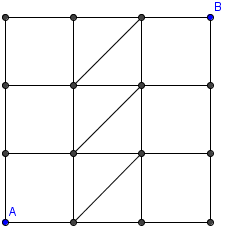Difference between revisions of "1997 PMWC Problems/Problem I15"
(New page: 26) |
(sol) |
||
| Line 1: | Line 1: | ||
| − | 26 | + | == Problem == |
| + | How many paths from A to B consist of exactly six line | ||
| + | segments (vertical, horizontal or inclined)? | ||
| + | |||
| + | [[Image:1997_PMWC-I15.png]] | ||
| + | |||
| + | == Solution == | ||
| + | [[Casework]]: | ||
| + | |||
| + | *Ignoring the diagonal segments, there are <math>\frac{6!}{3!3!} = 20</math> paths. | ||
| + | *Traversing the diagonals, we quickly find that the path must run through exactly 2 diagonals. There are <math>{3\choose2} = 3</math> pairs of diagonals through which this is possible; quick counting shows us that each pair of diagonals yields 2 paths. So there are 6 more cases here. | ||
| + | |||
| + | In total, we get <math>20 + 6 = 26</math> paths. | ||
| + | |||
| + | == See also == | ||
| + | {{PMWC box|year=1997|num-b=I14|num-a=T1}} | ||
| + | |||
| + | [[Category:Introductory Combinatorics Problems]] | ||
Revision as of 17:16, 8 October 2007
Problem
How many paths from A to B consist of exactly six line segments (vertical, horizontal or inclined)?
Solution
- Ignoring the diagonal segments, there are
 paths.
paths. - Traversing the diagonals, we quickly find that the path must run through exactly 2 diagonals. There are
 pairs of diagonals through which this is possible; quick counting shows us that each pair of diagonals yields 2 paths. So there are 6 more cases here.
pairs of diagonals through which this is possible; quick counting shows us that each pair of diagonals yields 2 paths. So there are 6 more cases here.
In total, we get ![]() paths.
paths.
See also
| 1997 PMWC (Problems) | ||
| Preceded by Problem I14 |
Followed by Problem T1 | |
| I: 1 • 2 • 3 • 4 • 5 • 6 • 7 • 8 • 9 • 10 • 11 • 12 • 13 • 14 • 15 T: 1 • 2 • 3 • 4 • 5 • 6 • 7 • 8 • 9 • 10 | ||






 pairs of diagonals through which this is possible; quick counting shows us that each pair of diagonals yields 2 paths. So there are 6 more cases here.
pairs of diagonals through which this is possible; quick counting shows us that each pair of diagonals yields 2 paths. So there are 6 more cases here.



